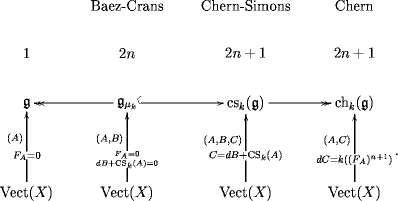Zoo of Lie n-Algebras
Posted by Urs Schreiber
We would like to share the following:
Jim Stasheff & U. S.
Zoo of Lie -Algebras
(pdf)
Abstract:
Higher order generalizations of Lie algebras have equivalently been conceived as Lie -algebras, as -algebras, or, dually, as quasi-free differential graded commutative algebras (quasi-“FDA”s, of “qfDGCA”s).
Here we present a menagerie of examples concentrated in low degrees, study their morphisms and discuss applications to higher order connections, in particular String 2-connections and Chern-Simons 3-connections.
I’d be grateful for comments.
This is work that has grown out of developments that I talked about in these entries:
Chern-Simons Lie-3-Algebra Inside Derivations of String Lie-2-Algebra


Re: Zoo of Lie n-Algebras
Very cool paper, though often above my level. But what is needed to move from an unstructured “zoo” or “menagerie” to a more complete classification? Is there something like a lattice of such examples? Is there a “height” metric according to which one knows that one has the “smallest” example? What finite objects get their interesting properties from entities in the zoo?